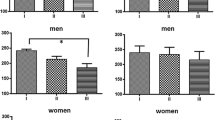We studied the effects of bioresonance application on mice with depressive-like behavior induced by stress. A chronic mild stress model was developed in mice to monitor the effects of bioresonance application. After that, behavioral tests were performed. In the forced swimming test, the animals of the long bioresonance therapy demonstrated shorter group immobility time in comparison with mice of the stress group and stress group without therapy (animals of this group were sacrificed at the same time point as therapy groups in order to reveal a possibility of spontaneously recover in animals after stress without therapy). In the tail suspension test, a decrease in immobility time was observed in the long bioresonance therapy group, stress group, and stress without therapy group. These changes in behavioral test results can indicate that the application of bioresonance in mice can be an effective method of treating depressive-like behavior, but these conclusions should be supported by additional experimental studies and the use of different frequencies.
Similar content being viewed by others
References
Sağlam H. Response of Cystinosis to Frequency Therapy (Bioresonance Treatment): A Case Report. J. US-China Med. Sci. 2017;14:90-97. https://doi.org/10.17265/1548-6648/2017.02.007
Galle M. Bioresonance therapy with children suffering from aller-gies—An overview about clinical reports. Eur. J. Integr. Med. 2009;1(4):234-235. https://doi.org/10.1016/j.eujim.2009.08.023
Liu LL, Wan KS, Cheng CF, Tsai MH, Wu YL, Wu WF. Effectiveness of MORA electronic homeopathic copies of remedies forallergic rhinitis: A short-term, randomized, placebo-controlled PILOT study. Eur. J. Integr. Med. 2013;5(2):119-125. https://doi.org/10.1016/j.eujim.2012.10.003
Herrmann E, Galle M. Retrospective surgery study of the therapeutic effectiveness of MORA bioresonance therapy with conventional therapy resistant patients suffering from allergies, pain and infection diseases. Eur. J. Integr. Med. 2011;3(3):e237-e244. https://doi.org/10.1016/j.eujim.2011.05.051
Barbault A, Costa FP, Bottger B, Munden RF, Bomholt F, Kuster N, Pasche B. Amplitude-modulated electromagnetic fields for the treatment of cancer: discovery of tumor-specific frequencies and assessment of a novel therapeutic approach. J. Exp. Clin. Cancer Res. 2009;28(1):51. https://doi.org/10.1186/1756-9966-28-51
Emara SO, EL-Kholy SM, Kazem AH, Hussein NA, Shams Al-dein RS. Therapeutic Effects of Low Frequency Pulsed Electromagnetic Fields on Rat Liver Cancer. Res. Inven. Int. J. Eng. Sci. 2013;2(9):17-18.
Kranjc S, Kranjc M, Scancar J, Jelenc J, Sersa G, Miklavcic D. Electrochemotherapy by pulsed electromagnetic field treatment (PEMF) in mouse melanoma B16F10 in vivo. Radiol. Oncol. 2016;50(1):39-48. https://doi.org/10.1515/raon-2016-0014
Nuccitelli R, Tran K, Sheikh S, Athos B, Kreis M, Nuccitelli P. Optimized nanosecond pulsed electric field therapy can cause murine malignant melanomas to self-destruct with a single treatment. Int. J. Cancer. 2010;127(7):1727-1736. https://doi.org/10.1002/ijc.25364
Mao QQ, Huang Z, Zhong XM, Xian YF, Ip SP. Brain-derived neurotrophic factor signalling mediates the antidepressant-like effect of piperine in chronically stressed mice. Behav. Brain Res. 2014;261:140-145. https://doi.org/10.1016/j.bbr.2013.12.020
Abelaira HM, Réus GZ, Quevedo J. Animal models as tools to study the pathophysiology of depression. Braz. J. Psychiatry. 2013;35(Suppl. 2.):S112-S120. https://doi.org/10.1590/1516-4446-2013-1098
Belovicova K, Bogi E, Csatlosova K, Dubovicky M. Animal tests for anxiety-like and depression-like behavior in rats. Interdiscip. Toxicol. 2017;10(1):40-43. https://doi.org/10.1515/intox-2017-0006
Cryan JF, Mombereau C. In search of a depressed mouse: utility of models for studying depression-related behavior in genetically modified mice. Mol. Psychiatry. 2004;9(4):326-357. https://doi.org/10.1038/sj.mp.4001457
Sakurai T, Yoshimoto M, Koyama S, Miyakoshi J. Exposure to extremely low frequency magnetic fields affects insulin-secreting cells. Bioelectromagnetics. 2008;29(2):118-124. https://doi.org/10.1002/bem.20370
Wyszkowska J, Shepherd S, Sharkh S, Jackson CW, Newland PL. Exposure to extremely low frequency electromagnetic fields alters the behaviour, physiology and stress protein levels of desert locusts. Sci. Rep. 2016;6:36413. https://doi.org/10.1038/srep36413
Martiny K, Lunde M, Bech P. Transcranial low voltage pulsed electromagnetic fields in patients with treatment-resistant depression. Biol. Psychiatry. 2010;68(2):163-169. https://doi.org/10.1016/j.biopsych.2010.02.017
Author information
Authors and Affiliations
Corresponding author
Additional information
Translated from Byulleten’ Eksperimental’noi Biologii i Meditsiny, Vol. 173, No. 3, pp. 318-322, March, 2022
Rights and permissions
About this article
Cite this article
Cabıoğlu, M.T., Aslan, E.L., Karabey, S.Z. et al. Effects of Bioresonance Application in Mice with Depressive-Like Behavior. Bull Exp Biol Med 173, 326–329 (2022). https://doi.org/10.1007/s10517-022-05543-x
Received:
Published:
Issue Date:
DOI: https://doi.org/10.1007/s10517-022-05543-x




